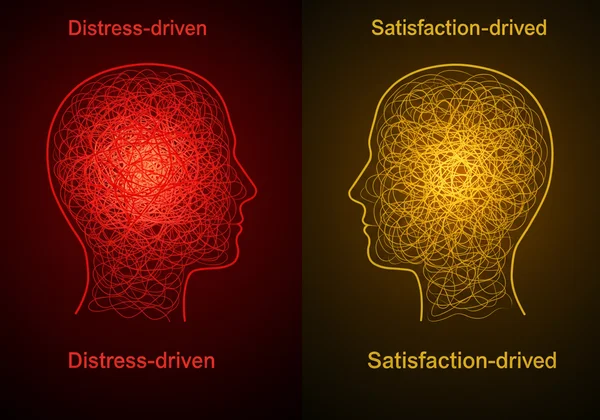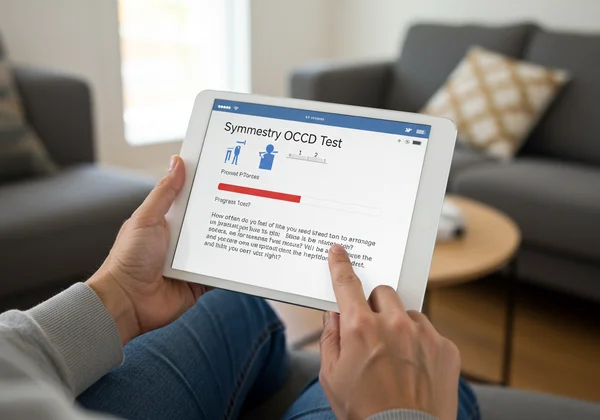Symmetry OCD Test: Signs of 'Just Right' OCD
Have you ever found yourself straightening a picture frame, not because it was crooked, but because it didn't feel right? Or perhaps you spend precious minutes arranging items on your desk until they achieve a perfect, yet unexplainable, sense of balance. This relentless pursuit of evenness and order can be exhausting. For many, it raises a critical question: How to know if I have OCD? While a preference for tidiness is common, when this need for precision causes significant anxiety and disrupts your life, you may be experiencing more than just a personality quirk. This is the world of Symmetry Obsessive-Compulsive Disorder (OCD), and understanding its signs is the first step toward finding clarity. If these feelings resonate, a Symmetry OCD Test could be your starting point. You can take our free OCD test to begin exploring these patterns in a safe, confidential space.
What is Symmetry and Ordering OCD?
Symmetry and Ordering OCD is a subtype of Obsessive-Compulsive Disorder characterized by an overwhelming need for things to be perfectly aligned, balanced, or "just right." Unlike a simple desire for a clean space, this urge is driven by intense anxiety and a deep-seated fear that something terrible will happen if the "correct" order is not achieved. It's not about aesthetics; it's about neutralizing a threat that feels incredibly real. People experiencing this often feel trapped in a cycle of obsessions (the distressing thoughts) and compulsions (the repetitive actions).

Common Obsessions: The Need for Evenness and Exactness
The mental component of Symmetry OCD revolves around intrusive thoughts and feelings of incompleteness. These obsessions are persistent and create significant distress. You might find your mind preoccupied with:
- An intense feeling that objects are "wrong" or "unbalanced."
- A nagging fear that if things aren't perfectly symmetrical, harm will come to you or a loved one.
- The need for your body movements to be even on both sides (e.g., if you tap your right foot, you must tap your left foot the same way).
- Distress over items not being in their "proper" place or aligned at perfect right angles.
- A constant mental review of patterns, arrangements, and sequences to ensure they are correct.
Typical Compulsions: Arranging, Counting, and Re-doing
To relieve the anxiety caused by these obsessions, a person performs compulsions. These are the repetitive behaviors or mental acts that temporarily neutralize the distress. For Symmetry OCD, these actions often include:
- Arranging and re-arranging: Repeatedly organizing books on a shelf, items on a nightstand, or icons on a computer screen until it feels "just right."
- Counting: Performing actions a certain number of times, or ensuring that the number of items on one side of a room matches the other.
- Re-doing actions: Rewriting a word until the letters are perfectly formed, re-tying shoelaces, or re-entering a room to ensure the motion was symmetrical.
- Touching and Tapping: Needing to touch objects with both hands or an equal number of times to maintain a sense of balance.
- Visual checks: Constantly scanning your environment to ensure everything remains in its exact, ordered state.
The 'Just Right' Feeling: Chasing an Impossible Standard
At the heart of this OCD subtype is the elusive 'just right' feeling. This isn't a logical conclusion but a visceral, internal sense of completeness or relief. The problem is that this feeling is often fleeting, and the standard for achieving it can become increasingly rigid and time-consuming. You might spend hours on a task that others would complete in minutes, all in pursuit of an internal state of calm that never seems to last, pushing you to perform the compulsion again and again.
Is It OCD or Just Perfectionism?
This is one of the most common points of confusion. Many high-achieving, organized individuals wonder if their meticulous habits are a sign of OCD. While both involve high standards, their core motivations and emotional outcomes are worlds apart. Answering this can help you decide if an ocd self test is a logical next step for you.
The Key Difference: Distress vs. Satisfaction
The most crucial distinction lies in the feeling that drives the behavior. Perfectionism is typically driven by a desire to achieve a positive outcome—a sense of accomplishment, pride, or external praise. While a perfectionist might be disappointed with a less-than-perfect result, the process is often geared towards a rewarding goal.
Symmetry OCD, conversely, is driven by a need to avoid a negative outcome—anxiety, fear, or a sense of impending doom. The actions are not performed for joy or satisfaction, but to quiet a screaming internal alarm. The primary feeling is distress, and the compulsion provides only temporary relief, not genuine fulfillment.

How Symmetry OCD Impacts Daily Life
When a desire for order becomes Symmetry OCD, it can have a profound and debilitating effect on your life. The time spent on rituals can make you constantly late for work, school, or social events. The mental exhaustion from constant checking and re-checking can drain your energy, making it difficult to focus on tasks or enjoy your hobbies.
Relationships can also suffer. A partner or family member may not understand why you can't leave the house until the towels are folded perfectly, leading to frustration and conflict. The internal struggle is often invisible, leaving you feeling isolated and misunderstood. Answering "Do I have OCD?" becomes less about a label and more about understanding the source of this significant life disruption.
When to Consider a Screening
If you recognize yourself in these descriptions, it may be time to consider a screening. Ask yourself:
- Do my ordering rituals take up more than an hour a day?
- Do these urges cause me significant anxiety or distress?
- Do my behaviors interfere with my job, my social life, or my relationships?
- Do I perform these actions to prevent a feared outcome rather than to achieve a positive one?
If you answered yes to any of these questions, taking a confidential and science-based online ocd test can provide valuable initial insights and help you organize your thoughts before speaking with a professional.
How Our Free Symmetry OCD Test Can Help
Navigating the uncertainty of these symptoms can be overwhelming. That's why a structured, accessible first step is so important. Our free OCD test is designed to be a supportive tool on your journey to understanding. It is not a diagnostic tool but a preliminary screening to help you identify patterns that may be consistent with OCD.

What to Expect from the OCD Self-Test
Our test is designed with your privacy and comfort in mind. The process is straightforward:
- Confidential & Free: There is no cost, and your responses are kept confidential.
- Science-Based: The questions are based on established psychological assessment principles, like the Obsessive-Compulsive Inventory (OCI), to reflect common OCD symptoms.
- Instant Feedback: You will receive a preliminary report immediately after completion, giving you a snapshot of your responses.
- Optional AI Report: For a deeper understanding, you can choose to receive a unique, AI-powered personalized report. This goes beyond a simple score to offer insights into how these patterns may affect your life, highlighting potential strengths and challenges.
Understanding Your Results for Next Steps
Receiving your results is not an end point; it is a beginning. The goal is to empower you with information. Your report can serve as a valuable, organized summary of your experiences, making it easier to have a productive conversation with a mental health professional. It provides the clarity needed to start your self-assessment and take control of your mental wellness journey.
Think you might have signs of Symmetry OCD? Get confidential, science-backed insights now. Take the Free OCD Test
From Uncertainty to Action: Your Next Steps
Living with the relentless need for things to be "just right" can be an isolating and anxiety-provoking experience. Differentiating between a personality trait like perfectionism and the distressing cycles of Symmetry OCD is crucial. Recognizing that your actions are driven by fear, not ambition, and that they are negatively impacting your life is a powerful realization.
Recognizing these patterns in yourself is a courageous and significant step. If you're ready to move from worry to understanding, we encourage you to get initial clarity with our confidential screening. You are not alone, and this can be the start of your path toward feeling better.
Frequently Asked Questions About OCD
Can I test myself for OCD?
Yes, you can use a self-screening tool to gain preliminary insights into your symptoms. An online OCD test, like the one offered on our site, is a great first step. It can help you identify patterns of thought and behavior that may be associated with OCD. However, it's crucial to remember that these tests are for informational purposes only and cannot replace a formal diagnosis from a qualified healthcare professional.
What are the main types of OCD?
OCD manifests in many ways, often called subtypes. Besides Symmetry and Ordering, common types include Contamination (fear of germs), Checking (fear of harm, like leaving a stove on), Rumination or Pure O (intrusive, taboo thoughts without visible compulsions), and Harm OCD (fears of causing harm to oneself or others). Many people experience symptoms from more than one subtype.
Is it OCD or anxiety?
This is a common question, as OCD is an anxiety disorder. The key difference is the presence of obsessions and compulsions. While Generalised Anxiety Disorder (GAD) involves persistent worry about various real-life concerns (like finances or health), OCD involves specific, often irrational obsessions that are managed through compulsive rituals. An accurate ocd test can help differentiate these patterns.
Can a person with OCD live a normal life?
Absolutely. With the right treatment and support, people with OCD can and do live full, happy, and productive lives. Effective therapies, such as Cognitive Behavioral Therapy (CBT) and Exposure and Response Prevention (ERP), help individuals manage their symptoms and reduce the impact of OCD on their daily functioning. Understanding your symptoms is the first step on that path.